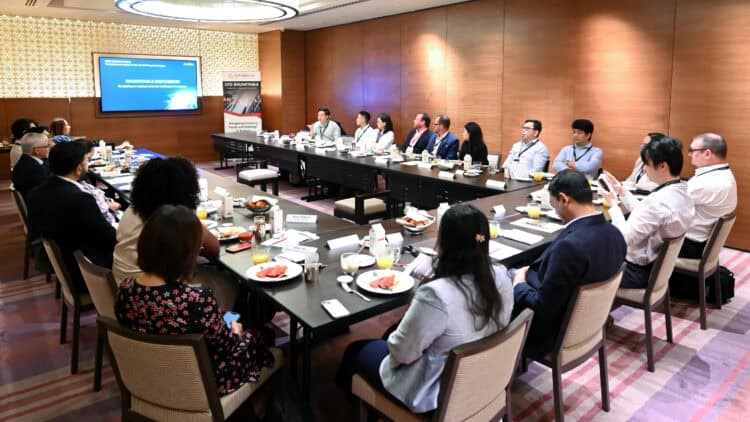Donald Trump's second administration, with its sweeping tariffs and protectionist policies, threatens to upend four decades of predictable global trade.
For Asia's corporate treasurers, discussing this seismic shift in Singapore's financial district at a recent FutureCFO roundtable, co-hosted by the Association for Financial Professionals (AFP), traditional hedging strategies now clash directly with geopolitical reality, forcing a complete rethink of their risk playbooks.
The ripple effects are already visible. According to a recent industry analysis, 55% of Singapore's domestic exports are potentially subject to tariff impacts, with only 40% currently exempt. This is a precarious balance that underscores the fragility of Asia's export-dependent economies.
Yet, as treasury leaders from across the region gathered at the roundtable to dissect these challenges, their responses revealed not panic but a sophisticated recalibration of risk management strategies that may define the next decade of corporate finance.
The tariff paradox: Direct impact vs. systemic risk
The most striking revelation from conversations with regional finance leaders is how few companies face direct tariff exposure, yet all are adapting their strategies.

"We're quantifying the company's additional cash exposure because we manufacture in Malaysia and sell into the US," explains Arwin Polintan, global VP of finance at Printronix. "The US team's general consensus is that with the mid-term election only about a year and a half away, there will be more policy changes before things stabilise.
"Given this, we are weighing the impact on both us and our customers and will prioritise stability of supply over shocking the market with price adjustments," he continues.
This temporal framing, which views policy volatility through electoral cycles, has become a crucial component of treasury planning.
The indirect effects prove more complex and pervasive. One delegate acknowledged that their business model has changed: "Our strategy has evolved from importing complete products to bringing in only the core framework. From there, we collaborate closely with local partners to complete the assembly and customisation, ensuring the final product meets regional needs and standards."
This operational pivot demonstrates how treasury considerations now drive fundamental business model decisions.
Among logistics providers in the region, one key consideration revolves around customer behaviour. Asked about how the recent tariff introductions are impacting the business of logistics, a senior treasury director overseeing multiple regions acknowledged that: "Wherever tariffs are applied, our customers feel the impact. For us, it's about being prepared to adapt quickly if customers shift their product movements."
The investment paralysis: When uncertainty freezes capital

From a treasury perspective, Murtaza Rangwala, President and CFO at Olam Global Agri commented that within the agri-commodity sector, the current business environment can best be described as an "investment limbo."
His assessment is telling, "There has been a clear deferral of several investment decisions. Notably, investments in the United States have been significantly affected due to prevailing policy uncertainty under the Trump-led political landscape."
This isn't merely about US investments. Rangwala continues, "There's a cascading effect on a global scale," given the scale and influence of the US economy, instability there has prompted a broader pullback, with investment momentum slowing in both the US and Europe."
The treasury implication is profound: working capital requirements shift as investment timelines extend, and liquidity planning must accommodate longer periods of uncertainty.
The energy sector, with its inherently long investment horizons, provides an interesting counterpoint.
One senior finance delegate explained the company's cautious approach to investments: "When we commit to any project, we take a considerable amount of time. Unless a project is at a critical decision point, we usually have the luxury to wait and observe how things develop."
Acknowledging the prevailing market uncertainties, she added: "One practical way we manage uncertainty is by running sensitivity scenarios. For example, if tariffs reach a certain threshold, we assess whether the project would still be viable."
Currency volatility: The new treasury frontline
The dollar's volatility has transformed foreign exchange risk management from a routine hedging exercise into a strategic imperative.

Jonathan Seow, CFO of biopharma company Moleac, captures the sentiment: "We are watching the US dollar — it's going up, going down every time Trump [says something]. We need to respond quite quickly. So for us, we have taken a more risk-averse approach. We have lowered all our risk tolerance in terms of exposure to USD."
This volatility is reshaping hedging strategies across the region. One delegate suggested the possibility of a comprehensive overhaul of the plan. Noting that due to significant fluctuations, they needed to adjust their foreign exchange (FX) strategy for various markets where they hold currencies.
The delegate further mentioned that they also had to modify their hedging strategies. The complexity goes beyond simple currency pairs, as companies are now implementing average strike-forward strategies and recalibrating hedge ratios based on market-specific volatility patterns.
The banking perspective adds another layer of nuance. Commenting on the US President's actions and statements, one delegate observed a "bit of a shift in the way global economies are working."
The China conundrum: Ring-fencing and capital efficiency
Beneath the tariff discussions lies a more fundamental question about China's exposure. Several companies are exploring what might be called "operational ring-fencing" — structuring Chinese operations as standalone entities with separate financing, IT infrastructure, and supply chains.
This approach enables companies to potentially isolate their Chinese operations if geopolitical tensions escalate while maintaining current integration benefits.
The treasury implications are substantial. One delegate described their approach: "When a major currency began internationalising a few years ago, our group established a dedicated currency pool. Each year, we received dividends in that currency, which we then consolidated centrally to fund expansion efforts. This strategy helps maintain treasury efficiency while preserving flexibility in the face of potential future market isolation."
However, the challenges of extracting capital from China remain formidable, with dividends remaining the primary mechanism for most companies to raise capital. This liquidity constraint is driving some treasurers at the roundtable to explore offshore CNY borrowing structures and cross-border cash pooling arrangements.
ESG and energy transition: Long-term strategy meets short-term volatility
The intersection of ESG commitments and current market volatility creates unique treasury challenges, particularly in the energy sector. Despite political challenges, the organisation maintains a consistent long-term strategy.
A senior executive noted, "While key political figures are important stakeholders, they are not the only ones influencing our approach." The company continues to invest in renewable initiatives but has become more selective in prioritising returns and enhancing shareholder value.

Chevron's regional finance head, Haider Manasawala, emphasises pragmatism:
"Having previously focused heavily on achieving net zero, energy companies are now shifting their attention towards reducing the carbon intensity of their production and products. This pivot is to ensure sustainable returns for their investors and shareholders."
This balance between ESG objectives and financial performance increasingly requires sophisticated treasury modelling to evaluate investment scenarios across different regulatory and market environments.
The liquidity imperative: Cash as a strategic weapon
The most consistent theme across the roundtable conversation is the elevated importance of liquidity management. During the COVID-19 pandemic period, organisations withheld spending due to uncertainty.
The same can be said of the current global market conditions arising from the trade tariffs being imposed by the US on most of its global trading partners, including Malaysia.
This cash buffering behaviour reflects broader treasury trends. Companies are prioritising liquidity over returns, extending cash forecasting horizons, and building a cash cushion for scenario planning.
The traditional trade-off between liquidity and yield has shifted decisively in favour of liquidity, with treasury teams justifying lower returns as insurance against uncertainty.
The way forward: Adaptive treasury management
As Asia's treasury professionals navigate this complex landscape, several trends emerge. First, the integration of geopolitical analysis into routine treasury operations — what some might call "political finance."
Second, the elevation of scenario planning from quarterly exercises to real-time strategic tools. Third, the evolution of hedging from risk mitigation to strategic positioning.
The most successful treasury operations appear to be those embracing what one might call "adaptive resilience". This is maintaining core operational efficiency while building optionality for multiple future scenarios. It requires new analytical capabilities, systems expertise, and, most importantly, the intellectual humility to acknowledge that traditional models may no longer apply.

As Byron Gardiner, the group treasurer of Traveloka, noted, the challenge isn't predicting the future but preparing for multiple possible futures simultaneously. In an era where a presidential tweet can reshape global supply chains overnight, that preparation may be the most valuable treasury skill of all.





